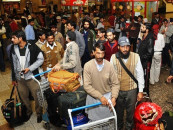Real fertility crisis in Pakistan
The concerns about fertility as an existential threat are largely overstated

The United Nations Population Fund (UNFPA) launched the State of World Population report 2025 on June 12 in Nairobi. This year's theme focuses on 'The Real Fertility Crisis: The Pursuit of Reproductive Agency in a Changing World'. While the report does not present new insights into the skewed fertility trends that have divided the globe, it provides a novel perspective on addressing what many politicians consider an existential threat. In some developing nations such as Pakistan, population growth and size are often seen as primary barriers to development and economic prosperity.
Conversely, while a significant decline in total fertility rates poses a challenge to economic stability in various developed countries — such as China, Japan, and the rapidly advancing economies of Southeast Asia — other nations have managed to maintain population growth despite low fertility. Countries like Australia, Canada, France, Luxembourg, New Zealand, Sweden, the UK and the US have consistently recorded fertility rates below replacement level of 2.1 yet are expected to continue growing beyond 2054 largely due to sustained immigration policies. Therefore, the concerns about fertility as an existential threat are largely overstated.
The socioeconomic, geopolitical and environmental ramifications of both high and low fertility rates are considerable, necessitating a thorough examination of their underlying factors. In the short term, socioeconomic elements, particularly urbanisation and evolving childbearing practices, significantly influence fertility trends. Since fertility rates are associated with the demographic transition — a seemingly widespread phenomenon - the potential public health consequences are quite detrimental. Changes in fertility patterns have intensified concerns related to birth rates, prompting governments to explore various policy options concerning childbirth and family planning.
To effectively address the challenge around fertility rates, it is essential to first dispel the common misconceptions. The foremost misconception is that the global fertility rate is so low that humanity faces the threat of extinction. The current world fertility rate is estimated to exceed 2.2, indicating that the world population is still growing. Another pervasive misconception about fertility is that religion is the primary driver of rapid population growth.
Although religious organisations, such as the Catholic Church and Islamic Shariah courts, may officially oppose artificial birth control, there is mostly a notable gap between the official stances of religious leaders and the actual behaviours of their followers. A compelling example is the Islamic Republic of Iran, which implemented one of the most successful family planning initiatives in history, leading to a remarkable decrease in the country's fertility rate from 6.5 to 1.6. A third major myth is the assumption that slower or faster population growth inherently harms the economy. Economic wellbeing depends more on the human capital and quality of skills than on population size or growth — especially in the era of artificial intelligence.
UNFPA conducted a survey of approximately 14,000 individuals across 14 countries, which together represent over 37% of the world's population. Most respondents expressed a desire to have two or more children. Notably, one in five individuals under the age of 50 fear they will not reach their ideal family size, while one in ten anticipate having fewer children than they would prefer — compared to only 7% who expect to have more.
Among respondents over the age of 50, more than 40% reported not having the number of children they would ideally have, with 31% having fewer and 12% having more. More than half of all respondents identified economic challenges — such as financial insecurity, job insecurity, the cost of housing and childcare — as barriers to having the number of children they desire. Almost one in five reported having experienced a situation where they were unable to access medical or health services related to contraception or reproductive health. These findings suggest that the real question is not about the attitude of the people but the policies and incentives that shape or limit their reproductive choices.
This report is the first-ever UN document that examines the reasons behind the declining birth rates. UNFPA supports nations in building demographic resilience by taking a comprehensive approach to their population dynamics, thereby alleviating adverse impacts and seizing opportunities presented by demographic shifts. Almost half of all pregnancies globally are unplanned. Furthermore, in the European Union, the number of childless single-person households surged by 21% from 2013 to 2023.
Considering growing concerns about a potential 'depopulation crisis', recent findings reveal that while most individuals desire to have children, many encounter overwhelming obstacles. Women and young individuals are often criticised for supposedly 'rejecting' parenthood, but surveys indicate that most people across various countries aspire to have two or more children. New statistics demonstrate that both women and men experience significant restrictions on their reproductive choices. The report reveals that two in three women in Pakistan cannot make decision about their reproductive health.
In addition, the family planning needs of 16% of women across Pakistan remain unmet. The quest of ensuring reproductive agency of people, especially women, demands recognition of their reproductive rights. Apart from economic and policy factors, social factors such as gender-based violence and child marriage limit the autonomy and reproductive agency of women and girls.
The challenges that hinder individuals from preventing unintended pregnancies frequently overlap with those that restrict their ability to achieve their desired family size, including economic marginalisation, gender inequality, inadequate access to healthcare and a pervasive sense of hopelessness about the future. I believe the key issue is recognising the significance of reproductive rights, which encompasses the quest for reproductive agency.
It is well-recognised that the realisation of women's reproductive rights is intrinsically linked to gender equality and women's empowerment. Gender-based violence significantly undermines women's ability to make informed decisions about their reproductive health and heightens their risk of experiencing adverse reproductive health outcomes.
















COMMENTS
Comments are moderated and generally will be posted if they are on-topic and not abusive.
For more information, please see our Comments FAQ